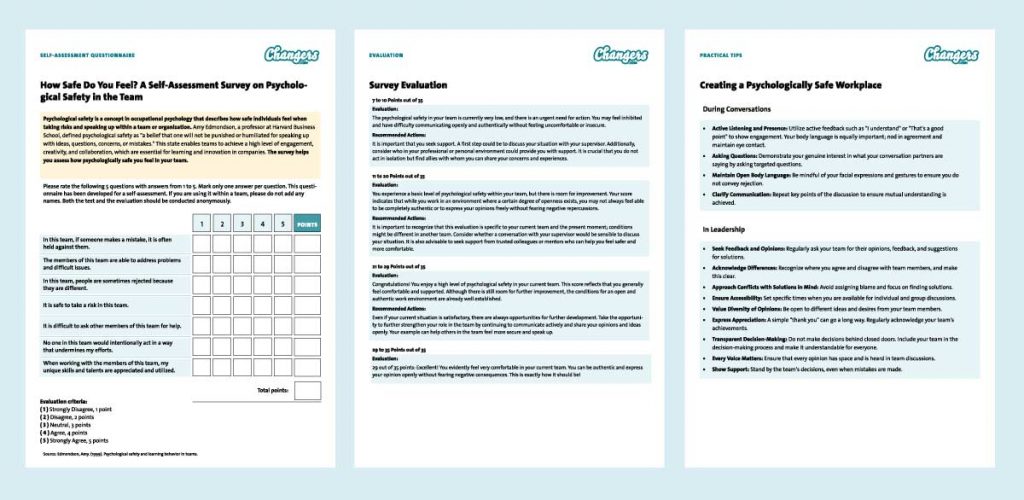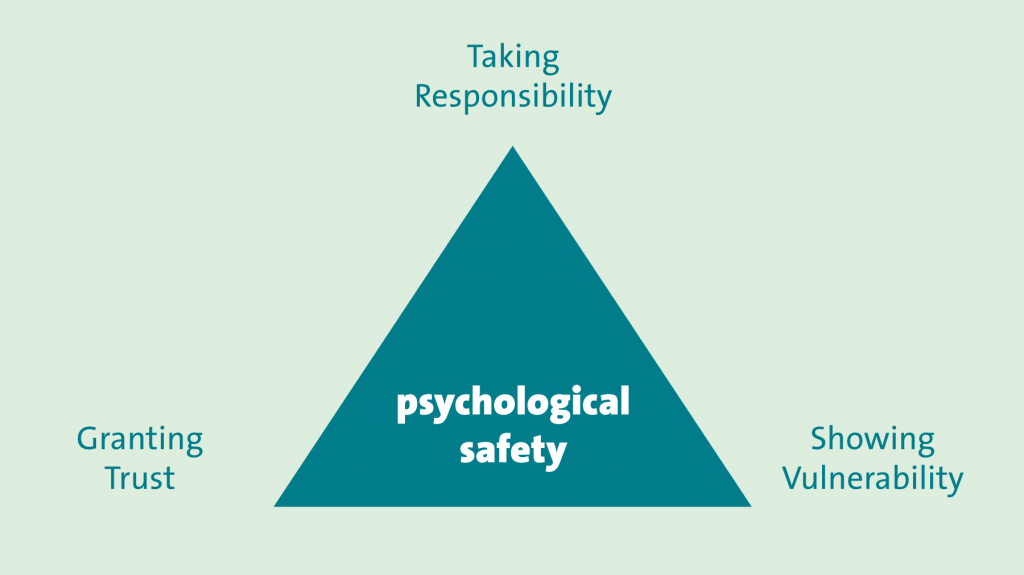
Psychological safety is a concept in occupational psychology that describes how secure individuals feel when taking risks and speaking up within a team or organization. Amy Edmondson, a professor at Harvard Business School, defined psychological safety as “a belief that one will not be punished or humiliated for speaking up with ideas, questions, concerns, or mistakes.” This state enables teams to achieve a high level of engagement, creativity, and collaboration, which are essential for learning and innovation in companies.
Relevance of Psychological Safety in Teams
The importance of psychological safety cannot be overstated, especially in times when work environments are becoming more dynamic and complex. Teams that exhibit a high degree of psychological safety tend to perform better for several reasons:
- Viewing mistakes as learning opportunities: In a safe atmosphere, employees freely learn from mistakes without fearing negative consequences.
- Encouraging openness and dialogue: Employees feel comfortable expressing ideas and concerns, which often leads to more innovative solutions.
- Increasing employee engagement: When employees feel safe to express their opinions, they feel valued and consider themselves integral parts of the team.
- Utilizing diversity more effectively: Teams freely express and leverage different perspectives and backgrounds, enriching the decision-making process.
Therefore, fostering psychological safety is a crucial task for leaders who want to create a culture of openness and respect in their teams to ultimately improve overall performance and employee well-being.
Psychological Safety Questionnaire: A Self-Test for Download
Discover with our questionnaire how psychologically safe you feel in your work environment. This self-test helps you assess key aspects of your team dynamics and provides valuable insights into whether you can express your opinion freely without fearing negative consequences. Learn how you and your team measure up in terms of psychological safety and use our tips to create a more supportive work climate.

Historical Overview: The Origins of Psychological Safety
The concept of psychological safety has its roots in social and organizational psychology and was popularized in the late 1990s through the pioneering work of Amy Edmondson, a professor at Harvard Business School. Edmondson coined the term “psychological safety” in her research, which initially focused on medical teams in hospitals.
In her 1999 study, Edmondson examined the behavior of teams in a hospital and found that the most effective teams paradoxically had the highest rate of reported errors. This led to the realization that these teams operated in an atmosphere where employees felt safe enough to report errors and problems without fear of punishment or embarrassment. This openness and transparency were crucial to improving performance and safety.
Edmondson soon extended her findings to the business world, where she demonstrated that psychological safety is a key component for effective teamwork, innovation, and performance in companies. Her research emphasized the importance of a culture that promotes openness and views the admission of mistakes not as a weakness but as an opportunity for learning and improvement.
Since then, the concept of psychological safety has gained significance in academic research and practice. It has been supported by further studies and has become a central topic in discussions about corporate culture, leadership styles, and the creation of effective work environments. Companies worldwide, including major corporations like Google, have recognized psychological safety as a crucial factor for the success of their teams and actively integrate this principle into their corporate cultures.
Three Aspects of Psychological Safety

Showing Vulnerability
Allowing vulnerability is essential for creating a culture where tasks are not just completed, but solutions are developed with the customer’s benefit in mind. This openness enables team members to admit freely if they have not understood a task and to request further clarification without fear. In a trust-based environment, this behavior is regarded as a strength rather than a weakness, leading to more effective processes and improved outcomes. Embracing vulnerability helps combat feelings of shame and inadequacy, which, in turn, facilitates the acceptance and implementation of agile practices like pair programming.
Granting Trust
Granting trust means navigating the fine line between hopes and fears. It starts with oneself and working on one’s credibility, which is apparent to others through integrity and clear intentions. When trust is granted, it creates a strong impetus for personal growth. This leads to stronger team cohesion, better alignments, a stronger market reputation, and ultimately societal relevance. These various levels of credibility, as described by Stephen M.R. Covey, demonstrate the profound impact of trust both inside and outside the organization.
Taking Responsibility
Taking responsibility means acting with competence, intention, autonomy, and a clear purpose. This contrasts with mere obligation, often arising as a reaction to others’ expectations and not voluntarily. In self-organized teams, a lack of responsibility often manifests as long throughput times and unclear responsibilities. True responsibility emerges from clear goals and the provision of necessary competencies. In environments where psychological safety is a priority, teams can openly address uncertainties, which lays the groundwork for effective responsibility taking and sets the stage for successful actions.
Guidelines: How to Promote Psychological Safety in Various Environments
Creating psychological safety is a central task for leaders to ensure innovative teamwork and strong team dynamics in all types of organizations. Here are practical strategies for promoting a safe work environment:
Promote Open Communication:
- Active Listening: Leaders should actively listen and respond to the concerns and suggestions of their employees, emphasizing the importance of psychological safety.
- Regular Check-Ins: Establish regular meetings where team members can express their thoughts and feelings in a safe environment, strengthening team dynamics.
Establish a Culture of Error:
- Errors as Learning Opportunities: Emphasize that errors are inevitable and provide valuable learning opportunities, contributing to the creation of psychological safety.
- Transparent Handling of Errors: Foster a culture where errors are openly discussed and analyzed to prevent similar issues in the future and create a safe work environment.
Inclusive Leadership Behavior:
- Valuing Diversity: Recognize and utilize the diverse perspectives and backgrounds of your team members, leading to innovative teamwork.
- Empowerment: Empower employees to take initiatives and assume responsibility for projects, enhancing team dynamics.
Strengthen Feedback Culture:
- Constructive Feedback: Regularly provide constructive feedback aimed at improvement and development, thereby promoting a safe work environment.
- Solicit Feedback: Encourage employees to provide feedback on your leadership and work processes to strengthen psychological safety.
Measure and Improve Psychological Safety:
- Surveys and Tools: Use specialized tools and surveys to regularly assess the level of psychological safety.
- Initiate Improvement Measures: Respond to feedback and survey results to promote continuous improvements in the safe work environment.
Training and Workshops:
- Offer Training: Invest in training and workshops to enhance awareness and skills for promoting psychological safety.
- Share Best Practices: Promote the exchange of best practices within and between teams, supporting innovative teamwork.
Be a Role Model:
- Authenticity and Integrity: Leaders should embody the values of psychological safety through their behavior.
- Consistency: Consistent actions build trust and show that the principles of psychological safety are taken seriously, strengthening team dynamics.
Case Study: Google – Project Aristotle

Background: Google is renowned for its data-driven approach to problem-solving, and Project Aristotle was no exception. Launched in 2012, this initiative aimed to understand what makes teams at Google successful. The project’s name references Aristotle’s famous saying, “The whole is greater than the sum of its parts,” reflecting the core idea that effective teamwork involves more than just the aggregation of individually talented people.
Methodology: The project collected data from over 180 Google teams and conducted more than 200 interviews. Researchers analyzed dozens of team attributes and dynamics to understand which factors most significantly impact team performance.
Results: The project’s findings were surprising and challenged many traditional assumptions about teamwork. Contrary to the common belief that the best teams are made up of the most talented individuals, Project Aristotle revealed that “soft” factors—like how team members interact, collaborate, and structure their work—are far more crucial. The most significant factor identified was psychological safety.
Definition of Psychological Safety at Google: Psychological safety was defined as a state where team members feel safe to take risks and be vulnerable in front of each other. This includes the freedom to express ideas and opinions without fear of ridicule or punishment.
Implementation:
- Promoting Open Communication: Google encouraged team leaders to foster an open communication culture where all members actively listen, respect diverse opinions, and provide constructive feedback.
- Creating a Safe Space: Developers crafted workshops and training programs to instruct leaders on creating environments that promote psychological safety.
- Implementing Regular Check-ins: The organization encouraged teams to meet regularly, not only to discuss work progress but also to address well-being and interpersonal relationships within the team.
Effects:
- Teams with high levels of psychological safety were not only more productive but also more innovative. They were able to respond more quickly to challenges and were more flexible in developing and implementing new ideas.
- These teams also showed higher employee satisfaction and lower turnover.
Google’s Project Aristotle has highlighted the importance of psychological safety in teams and underscores how critical this element is for success in the modern work environment. It demonstrates that fostering a culture that promotes psychological safety is a vital strategy for any organization seeking sustainable success.
Case Study: Pixar Animation Studios

Background: Pixar Animation Studios has earned global recognition for its innovative and creatively successful animated films, including “Toy Story,” “Finding Nemo,” and “Up.”A key aspect of the company’s culture is the promotion of psychological safety, deemed crucial for the creative process.
Philosophy: Pixar’s leadership firmly believes that creative ideas come from an environment where employees feel free to take risks and make mistakes. Ed Catmull, co-founder of Pixar, extensively described the concept of psychological safety in his book “Creativity, Inc.” He emphasizes the importance of creating a culture where employees dare to express their ideas without fear of embarrassment or criticism.
Implementation:
- Braintrust Meetings: One of Pixar’s key initiatives, the Braintrust meetings, bring teams together to discuss projects and offer open feedback. These meetings foster a culture of absolute equality and lack of authority dynamics, enabling open discussions and honest feedback without hierarchical barriers.
- Error-Friendly Culture: Pixar encourages its employees to embrace mistakes as integral to the creative process. The company supports this approach by recognizing and celebrating failures at specific company events, allowing teams to share and learn from their “glorious failures.”
- Support and Resources: The company ensures that all teams have the necessary resources and support to experiment and try out new ideas without strict budget constraints or fear of financial failure.
Effects:
- The Braintrust meetings have proven extremely effective by creating an environment where critical feedback is constructively and personally uncritically expressed. This leads to continuous improvement of projects and strengthens trust within the teams.
- The culture that views errors as an essential part of the learning process has led to steady innovation. Employees feel safe enough to take creative risks, leading to some of the most successful animated films in history.
Pixar’s approach to psychological safety shows how crucial a supportive and error-tolerant culture is for creative companies. By giving employees the freedom to experiment and learn from mistakes, they can fully unleash their creativity and achieve exceptional results.
Case Study: Edmondson’s Hospital Study

Background: Amy Edmondson, a professor at Harvard Business School, conducted an influential study to examine the effects of team climate and psychological safety in hospital settings. Her research focused on how the sense of psychological safety affects the ability of team members to report errors and propose innovative solutions.
Methodology: Edmondson collected and analyzed data from various hospital teams to determine the frequency of error reporting. She also examined the correlation between error reporting and other measures of team performance, including quality of care and patient satisfaction.
Key Findings:
- Higher Error Reporting Rate: Interestingly, Edmondson found that teams with high psychological safety tended to report more errors. While this may seem counterintuitive, it suggests that these teams were more willing to admit and openly discuss mistakes.
- Error Reporting as a Safety Indicator: The study showed that the frequency of error reporting is a significant indicator of psychological safety within the team. In environments where employees felt safe to admit errors, there was more open communication and stronger collaboration.
Implementation and Consequences:
- Training and Guidelines: In response to the study findings, many hospitals conducted training to raise awareness of the importance of psychological safety. They also developed guidelines that promote open communication and error reporting.
- Cultural Change: Many healthcare facilities began to foster a culture that not only tolerates errors but also views them as an essential element of learning and improvement.
Effects:
- Improved Patient Safety: Teams that exhibited high psychological safety were able to communicate and collaborate more effectively, leading to improved patient care and higher safety standards.
- Promotion of Innovation: A safe clinical environment also encouraged the willingness to try and implement innovative practices, which ultimately led to better patient care.
Edmondson’s study provides compelling evidence of how critical psychological safety is for effective teamwork and high performance standards in critical environments like hospitals. These findings have broad implications for organizations of all kinds, especially in areas where errors can have serious consequences, and where continuous learning is essential to improving outcomes.
Case Study: Bridgewater Associates

Background: Ray Dalio founded Bridgewater Associates, the world’s largest hedge fund, renowned for its unconventional work methods based on principles of radical truth and radical transparency. Dalio stresses the importance of open communication and honest feedback as tools for achieving personal growth and organizational effectiveness.
Philosophy: Bridgewater’s philosophy is based on the idea that an honest and transparent confrontation with reality and an understanding of effective decision-making processes are central to success. Dalio has extensively described these principles in his book “Principles: Life and Work.”
Implementation:
- Radical Transparency: At Bridgewater, a system records nearly every meeting and exchange, making them accessible to all employees. This approach allows team members from any level of the company to access the same information and facilitates learning across the board.
- Radical Truth: Bridgewater encourages employees to express their honest opinions constructively, even when they differ from management’s views. The company views criticism as an opportunity for improvement rather than a personal attack.
- Algorithmic Decision Process: Bridgewater uses data-driven approaches and algorithms to objectify and depersonalize decisions, thereby minimizing subjective biases and emotional reactions.
Challenges and Criticism:
- Bridgewater’s culture is not suitable for everyone, and the high intensity of open criticism has led to controversies and discussions about the psychological burden on employees.
- Some former employees have described the company’s culture as too harsh and emotionally taxing, while others appreciate the learning opportunities and growth they experienced in this unique environment.
Effects:
- Improved Performance and Innovation: Bridgewater’s principles have propelled the company to become one of the most successful hedge funds ever. Its culture of radical transparency and truth rapidly identifies and corrects mistakes, boosting innovation.
- Personal and Professional Growth: Many employees have noted significant personal and professional development at Bridgewater, attributed to the culture of open feedback.
Bridgewater Associates as a Case Study: This firm exemplifies how a company can adopt radical transparency and psychological safety in a high-performance, competitive environment. Although sometimes controversial, this approach offers valuable insights into the potential and challenges of such a distinctive corporate culture.
Have questions? Contact us!
We look forward to getting to know you and exploring the potential of the Changers Fit App for your company together.

Daniela Schiffer
d.schiffer@changers.com
+49 172 367 40 38


